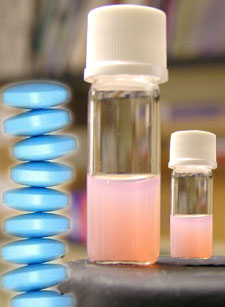|
 Drug description :
Drug description :
Each tablet contains 150 mg or 300mg propafenone HCl.
Indications :
Propafenone is indicated for the prophylaxis and treatment of
ventricular arrhythmias. Propafenone is also indicated for the
prophylaxis and treatment of paroxysmal supraventricular
tachyarrhythmias which include paroxysmal atrial
flutter/fibrillation and paroxysmal re-entrant tachycardias
involving the AV node or accessory bypass tracts, when standard
therapy has failed or is contra-indicated.
 Adult Dosage :
Adult Dosage :
It is recommended that Propafenone therapy should be initiated
under hospital conditions, by a physician experienced in the
treatment of arrhythmias. The individual maintenance dose should
be determined under cardiological surveillance including ECG
monitoring and blood pressure control. If the QRS interval is
prolonged by more than 20%, the dose should be reduced or
discontinued until the ECG returns to normal limits.
Adults: Initially, 150 mg three times daily increasing at a
minimum of three-day intervals to 300 mg twice daily and if
necessary, to a maximum of 300 mg three times daily.
The tablets should be swallowed whole and taken with a drink after
food. A reduction in the total daily dose is recommended for
patients below 70 kg bodyweight.
Dosage in impaired liver function: Propafenone is extensively
metabolised via a saturable hepatic oxidase pathway. In view of
the increased bioavailability and elimination half-life of
propafenone, a reduction in the recommended dose may be necessary.
Dosage in impaired renal function: Although the elimination of
propafenone and its major metabolite is not affected by renal
impairment, Propafenone should be administered cautiously.
 Child Dosage :
Child Dosage :
A suitable dosage form of Propafenone for children is not
available.
 Elderly Dosage :
Elderly Dosage :
Higher plasma concentrations of propafenone have been noted during
treatment. Elderly patients may therefore respond to a lower dose.
 Contra Indications :
Contra Indications :
Known hypersensitivity to propafenone or to any of the other
ingredients.
Propafenone is contra-indicated in patients with uncontrolled
congestive heart failure, cardiogenic shock (unless
arrhythmia-induced), severe bradycardia, uncontrolled electrolyte
disturbances, severe obstructive pulmonary disease or marked
hypotension.
Propafenone may worsen myasthenia gravis.
Unless patients are adequately paced, Propafenone should not be
used in the presence of sinus node dysfunction, atrial conduction
defects, second degree or greater AV block, bundle branch block or
distal block.
Minor prolongation of the PR interval and intra-ventricular
conduction defects (QRS duration of less than 20%) are to be
expected during treatment with Propafenone and do not warrant dose
reduction or drug withdrawal
 Special Precautions :
Special Precautions :
The weak negative inotropic effect of Propafenone may assume
importance in patients predisposed to cardiac failure.
In common with other anti-arrhythmic drugs, Propafenone has been
shown to alter sensitivity and pacing threshold. In patients with
pacemakers, appropriate adjustments may be required.
There is potential for conversion of paroxysmal atrial
fibrillation to atrial flutter with accompanying 2:1 or 1:1
conduction block.
Because of the beta-blocking effect, care should be exercised in
the treatment of patients with obstructive airways disease or
asthma.
As with other class IC anti-arrhythmic agents, patients with
structural heart disease may be predisposed to serious adverse
effects.
It is essential that each patient given Propafenone be evaluated
electrocardiographically and clinically prior to and during
therapy to determine whether the response to Propafenone supports
continued treatment.
 Interactions :
Interactions :
The effects of Propafenone may be potentiated if it is given in
combination with other local anaesthetic type agents or agents
which depress myocardial activity.
Propafenone has been shown to increase the plasma levels of
digoxin and caution should be exercised with regard to digitalis
toxicity.
Propafenone has been shown to increase the plasma levels of oral
anticoagulants, with an accompanying increase in prothrombin time,
which may require a reduction in the dose of oral anticoagulants.
Plasma levels of propafenone may be increased by concomitant
administration of cimetidine.
Increased propranolol and metoprolol plasma levels have been
observed when these beta-blockers were used concurrently with
Propafenone. Thus, dose reduction of these beta-blockers may be
required. Details of interactions with other beta-blockers are not
known.
Coadministration of propafenone hydrochloride with drugs
metabolised by CYP2D6 (such as venlafaxine) might lead to
increased levels of these drugs.
Drugs that inhibit CYP2D6, CYP1A2 and CYP3A4, e.g. ketoconazole,
cimetidine, quinidine, tropisetron, dolasetron, mizolastine,
erythromycin and grapefruit juice may lead to increased levels of
propafenone hydrochloride. When propafenone hydrochloride is
administered with inhibitors of these enzymes, the patients should
be closely monitored and the dose adjusted accordingly.
Due to the potential for increased plasma concentrations,
co-administration of 800-1200mg/day doses of ritonavir and
propafenone hydrochloride is contraindicated.
Combination therapy of amiodarone and propafenone hydrochloride
can affect conduction and repolarisation and lead to abnormalities
that have the potential to be proarrhythmic. Dose adjustments of
both compounds based on therapeutic response may be required.
No significant effects on the pharmacokinetics of propafenone or
lidocaine have been seen following their concomitant use in
patients. However, concomitant use of propafenone hydrochloride
and intravenous lidocaine have been reported to increase the risks
of central nervous system side effects of lidocaine.
Phenobarbital is a known inducer of CYP3A4. Response to
propafenone hydrochloride therapy should be monitored during
concomitant chronic phenobarbital use.
There has been a report of the lowering of propafenone levels by
rifampicin, via the hepatic mixed oxidase system. This reduction
may lead to breakthrough arrhythmias.
Cases of possible interactions with cyclosporin (levels increased
with deterioration in renal function), theophylline (levels
increased), desipramine (levels increased) have also been
reported.
Due to the arrhythmogenic effects of tricyclic and related
antidepressants and/or neuroleptics, these drugs may interact
adversely when used concomitantly with anti-arrhythmic drugs
including propafenone.
Concomitant administration of propafenone hydrochloride and
fluoxetine in extensive metabolisers increased the S propafenone
Cmax and AUC by 39 and 50% and the R propafenone Cmax and AUC by
71 and 50%. Elevated levels of plasma propafenone may occur when
propafenone hydrochloride is used concomitantly with paroxetine.
Lower doses of propafenone may be sufficient to achieve the
desired therapeutic response.
| Information about Generic Medicines |
|
 |
|
|
|
| Information about Manufacturing
|
|
 |
| |
|







